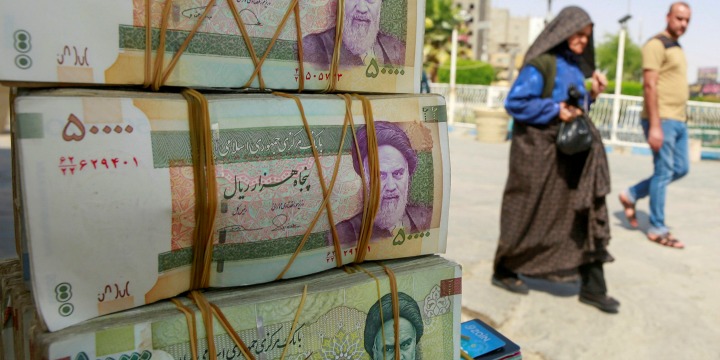Iran Recession to Deepen, Reserves to Fall to $73 Billion by March: IIF
 by Reuters and Algemeiner Staff
by Reuters and Algemeiner Staff

Iranian rial currency notes are seen at a market in Najaf, Iraq, Sept. 22, 2019. Photo: Reuters / Alaa al-Marjani / File.
Hit by sanctions curbing oil sales, Iran’s economy is set to fall deeper into recession this fiscal year and foreign reserves could drop to $73 billion by March, a loss of almost $40 billion in two years, the Institute of International Finance said.
The economy shrank by 4.6 percent in the 2018-2019 fiscal year and the contraction is expected to deepen to 7.2 percent in the current fiscal year, the IIF, a finance industry body, said this week.
The United States last week sanctioned 17 Iranian metal producers and mining companies in response to Iran’s attack on US troops in Iraq, which was retaliation for the US killing of an Iranian general in a drone strike in Baghdad.
Iran is not a major metals producer but the sanctions add pressure on the economy, crippled by a decline in volume of exports of crude oil and condensates, which fell from a peak of 2.8 million barrels per day in May 2018 to less than 0.4 million barrels a day in recent months.
“The fall in imports has only partly offset the drastic decline in exports. As a result, the current account balance has shifted to a small deficit for the first time since 1998,” the IIF said.
Iran saw its oil revenues surge after a 2015 nuclear pact between Tehran and world powers ended a sanctions regime imposed three years earlier over its disputed nuclear program.
But new sanctions brought in after US President Donald Trump withdrew from that deal in 2018 are the most painful imposed by Washington.
‘More risks than opportunities’
The IIF said that if the US maintained sanctions, then “after two years of deep recession, growth would remain subdued over the medium term, unemployment rate would increase further to over 20%, and official reserves would continue their decline to about $20 billion by March 2023.”
In contrast, in a scenario in which the US lifts sanctions, Iran’s economic growth could exceed 6 percent annually, with reserves resuming their rise to $143 billion and nominal GDP could double to $639 billion by March 2024, it said. The Iranian fiscal year starts in March.
“The US strategy to inflict a heavy economic and political toll on the Islamic Republic through a coordinated sanctions policy is unlikely to change over the coming months,” said Robert Mogielnicki, a resident scholar at the Washington-based Arab Gulf States Institute.
“With President Trump likely to remain in office through much of 2020, and potentially until 2024, the prospects for a durable agreement between the US and Iran appear remote. The Iranian economy therefore confronts more risks than opportunities in the short and medium terms,” he said.
A drop in the Iranian currency following the reimposition of sanctions has disrupted Iran’s foreign trade and boosted annual inflation, which the International Monetary Fund has forecast will be 31 percent this year.
With hydrocarbon revenues falling by about 70 percent, Iran — a leading member of the Organization of the Petroleum Exporting Countries (OPEC) — is expected to have a fiscal deficit of around 2 percent of GDP in the fiscal year 2020-2021, despite higher taxes and cuts in fuel and electricity subsidies, according to the IIF.
Iran’s president presented a draft state budget of about $39 billion to parliament in December, saying it was designed to resist US sanctions by limiting dependence on oil exports.
The budget forecasts revenues for oil, gas and condensates falling 40 percent, leaving a gap it plans to plug by using state bonds and selling state properties.
 Police Stop Anti-Zionist Agitators From Accessing Florida University President’s Home as Students Revolt Nationwide
Police Stop Anti-Zionist Agitators From Accessing Florida University President’s Home as Students Revolt Nationwide Nearly One in Five Young People Sympathize With Hamas, 29% Say US Should Reduce or End Alliance With Israel: Poll
Nearly One in Five Young People Sympathize With Hamas, 29% Say US Should Reduce or End Alliance With Israel: Poll Ilhan Omar Silent After Daughter’s Arrest, Suspension for Role in Columbia University Anti-Israel Protest
Ilhan Omar Silent After Daughter’s Arrest, Suspension for Role in Columbia University Anti-Israel Protest Cultural Center Backed by Iran’s Revolutionary Guard Plans to Produce Films About Attack on Israel
Cultural Center Backed by Iran’s Revolutionary Guard Plans to Produce Films About Attack on Israel How Does Ilhan Omar Really Feel About Iran?
How Does Ilhan Omar Really Feel About Iran? This Passover, Combine Respect for Tradition with the Courage to Innovate
This Passover, Combine Respect for Tradition with the Courage to Innovate Israel’s Iran Attack Carefully Calibrated After Internal Splits, US Pressure
Israel’s Iran Attack Carefully Calibrated After Internal Splits, US Pressure Palestinian Cameramen Exposed in New Footage Documenting Oct. 7 Atrocities Side by Side with Terrorists
Palestinian Cameramen Exposed in New Footage Documenting Oct. 7 Atrocities Side by Side with Terrorists US Money to Convicted Terrorists; US Training to Aspiring Terrorists
US Money to Convicted Terrorists; US Training to Aspiring Terrorists Man Arrested in Paris After Iran Consulate Incident
Man Arrested in Paris After Iran Consulate Incident



 Israel’s Iran Attack Carefully Calibrated After Internal Splits, US Pressure
Israel’s Iran Attack Carefully Calibrated After Internal Splits, US Pressure This Passover, Combine Respect for Tradition with the Courage to Innovate
This Passover, Combine Respect for Tradition with the Courage to Innovate How Does Ilhan Omar Really Feel About Iran?
How Does Ilhan Omar Really Feel About Iran? Cultural Center Backed by Iran’s Revolutionary Guard Plans to Produce Films About Attack on Israel
Cultural Center Backed by Iran’s Revolutionary Guard Plans to Produce Films About Attack on Israel Ilhan Omar Silent After Daughter’s Arrest, Suspension for Role in Columbia University Anti-Israel Protest
Ilhan Omar Silent After Daughter’s Arrest, Suspension for Role in Columbia University Anti-Israel Protest